Jiangxi is home to many historical and cultural cities, such as Tengwang Pavilion in Nanchang, the ancient city walls of Ganzhou, and Lushan in Jiujiang. Each of these places is steeped in rich history. Jiangxi also boasts a UNESCO World Natural Heritage site, Sanqing Mountain, known for its steep cliffs and seas of clouds that make you feel as if you are in a fairyland. Lushan is another breathtaking destination, with its lush mountains and clear waters, creating a picturesque scene that will leave you in awe. Additionally, there are many scenic spots like Longhu Mountain and Wugong Mountain waiting for you to explore and discover.
Let’s embark on an unforgettable journey to explore the 23 most enjoyable attractions in Jiangxi! At the end of the article, you’ll find a [Food Guide] and [Pit Avoidance Guide] for traveling in Jiangxi.
Attraction Highlights
1,Lushan National Park
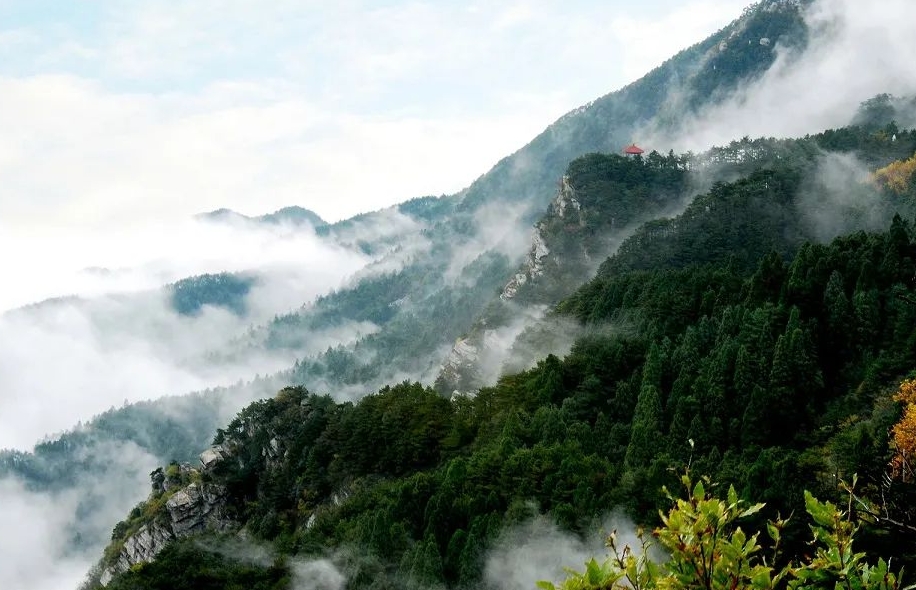
Lushan National Park
Recommended Rating: ★★★★★
Lushan National Park is located in the southern part of Jiujiang City, Jiangxi Province. It lies to the north of the Yangtze River and to the south of Poyang Lake, renowned for its majestic, unique, dangerous, and beautiful scenery. Lushan is one of China’s most famous mountains, with most of its peaks rising over 1,000 meters above sea level. The main peak, Hanyang Peak, reaches a height of 1,474 meters, making it a renowned tourist destination and summer resort in China. Lushan is not only famous for its stunning natural beauty but also for its profound cultural heritage. Countless poets and scholars have left behind precious works, such as Su Shi’s famous line, “I can’t tell the true face of Lushan because I am within it,” which has become a cultural representation of the mountain.
Lushan is also home to many historical sites, such as the Three Tiers Waterfall, Five Old Men Peaks, and White Deer Cave Academy, each bearing rich history and culture. In 1996, Lushan was included in the UNESCO World Heritage List as a site of both natural and cultural significance, making it a treasure of China and the world. In April, the mountain comes alive with blooming azaleas, adding to its natural charm.
Ticket Price: Adult ticket: 160 RMB/person, Child ticket: 80 RMB/person
Opening Hours: Open all year round. The operation hours for the mountain cable cars are as follows: [Peak Season] (May–October): 7:30 AM–8:30 PM and 7:30 AM–6:30 PM; [Low Season] (November–April of the following year): 7:30 AM–6:00 PM.
Address: 19 Hexi Road, Guling Town, Lushan City, Jiujiang
Transportation: There are three main entrances to Lushan: Lushan South Gate Tourist Shuttle Center, Lushan North Gate Tourist Shuttle Center, and Lushan Cable Car Lower Station. Visitors can take the Lushan tourist bus or cable car up and down the mountain. From Jiujiang Station, you can take a bus or taxi to the North Gate or Cable Car Lower Station. From Lushan Station, head to the South Gate or Cable Car Lower Station. The Lushan tourist bus has multiple stops along the mountain, making it easy to reach various attractions.(What is Lushan known for?)
2,Tengwang Pavilion
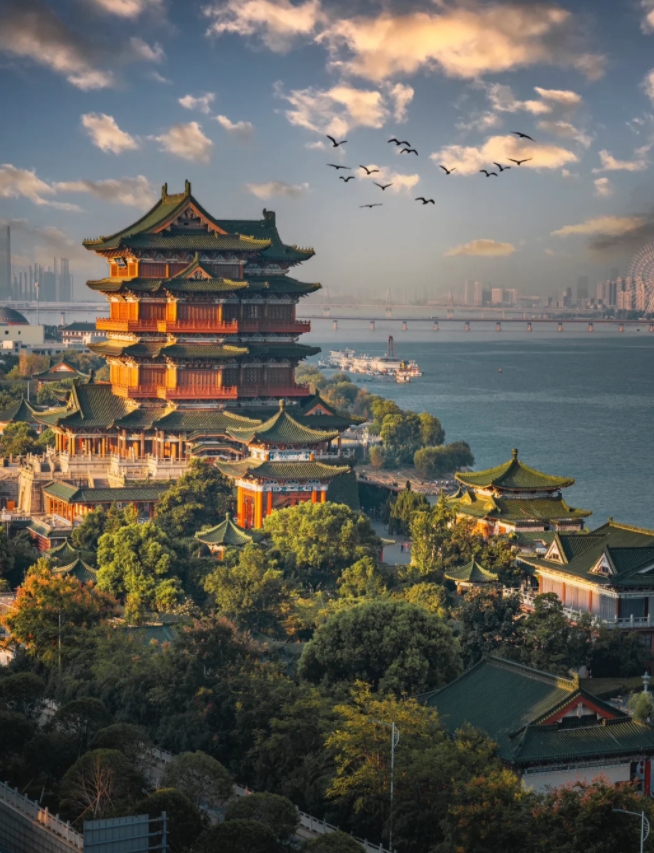
Tengwang Pavilion
Recommended Rating: ★★★★★
English official website:http://web.cntwg.com/english/
Tengwang Pavilion, located in Nanchang, Jiangxi Province, on the east bank of the Gan River, is a landmark building in the city and a symbol of ancient Yuzhang culture. Built in the fourth year of Tang Yonghui (653 AD), it was constructed by Li Yuanying, brother of Emperor Taizong of the Tang Dynasty. It has undergone several restorations, with the current structure being rebuilt in 1985. Tengwang Pavilion became world-famous thanks to the early Tang poet Wang Bo and his famous work, Preface to Tengwang Pavilion. Along with Yueyang Tower in Hunan and Yellow Crane Tower in Wuhan, it is known as one of the “Three Great Towers of Jiangnan.”
The main structure of Tengwang Pavilion stands 57.5 meters tall and covers an area of 13,000 square meters. Its base is a 12-meter-high platform symbolizing the ancient city walls, and above it, the main pavilion follows a design of “three visible floors and seven hidden ones,” with seven floors inside. The pavilion’s antique design includes intricately carved screens and red lacquered columns, creating an elegant and majestic appearance. Inside the pavilion are a wealth of cultural and historical artifacts, making it a perfect blend of culture and natural beauty.
Ticket Price: Adult ticket: 50 RMB, Group ticket: 45 RMB, Child and full-time student tickets (for those between 1.2 meters and 1.5 meters tall) are 25 RMB, and Nanchang residents also enjoy a price of 25 RMB. The price for official online tickets and other network OTA tickets is 45 RMB, but these must be reserved a day in advance. Free admission is available for children under 1.2 meters tall, seniors over 65, active military personnel, the disabled, and one companion for people with severe disabilities.
Opening Hours: Open all year round
Address: Ganjiang East Road, Donghu District, Nanchang, Jiangxi Province, where the Gan River meets the old course of the Fu River.
Transportation: Tengwang Pavilion is easily accessible by several bus routes, with nearby stops such as Rongmen Road and Tengwang Pavilion stops. Additionally, there is a subway station close to the pavilion, making it convenient for visitors to arrive via public transport.(When was the Pavilion of Prince Teng built?)
3. Bada Shanren Memorial Hall
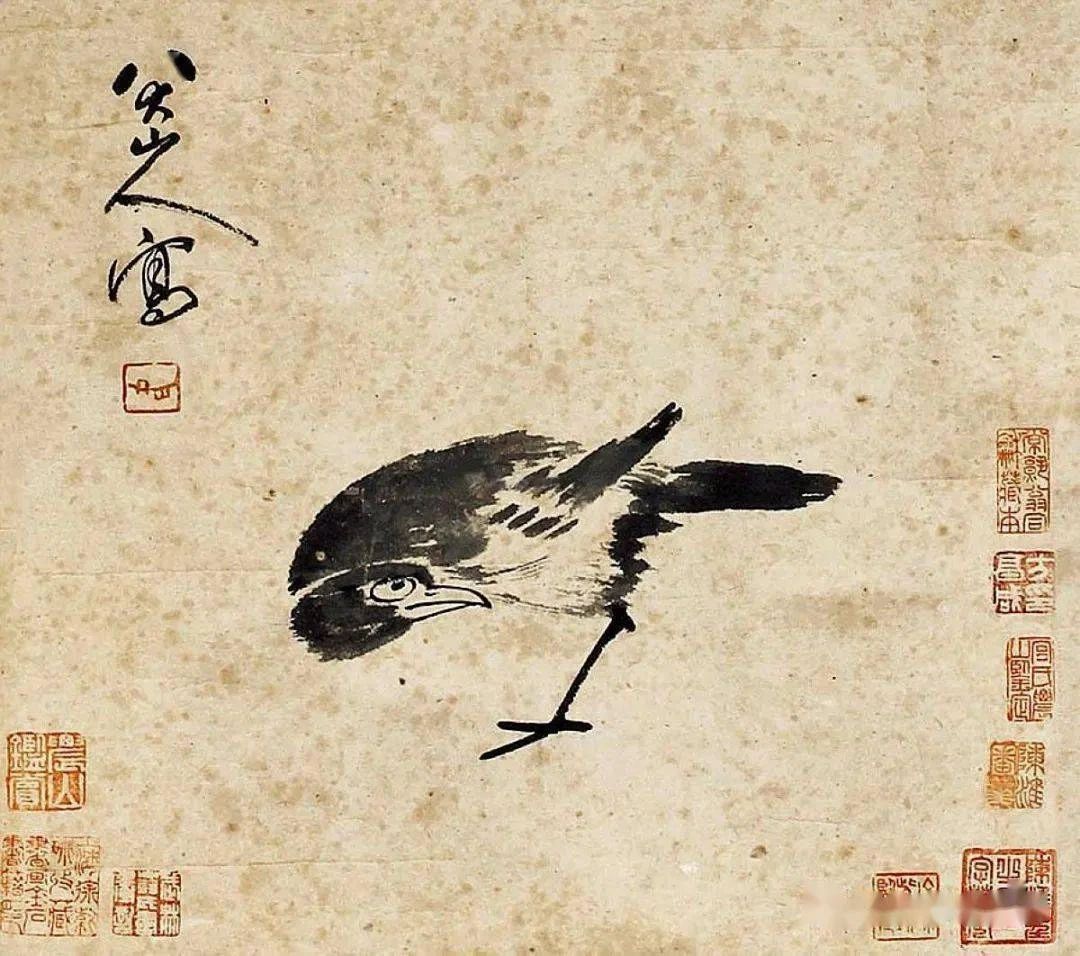
Works of Ba Da Shan Ren
Recommended Rating: ★★★★
The Bada Shanren Memorial Hall, located in the Qingyunpu District of Nanchang, Jiangxi, is the first memorial hall in China dedicated to an ancient painter and is classified as a national first-class museum. The hall covers approximately 39 acres, surrounded by water, resembling the fish often depicted in Bada Shanren’s paintings. The landscape integrates seamlessly with Meihu Lake, forming a natural Tai Chi pattern where land and water coexist in harmony, creating a beautiful and serene scene.
The layout of the museum is unique. To the south is the “Qingyunpu” Taoist Temple, which has a simple and elegant design and primarily displays Bada Shanren’s life and artistic introduction. To the north is the modern and abstract “Original Works Exhibition Hall,” also known as “Zhenshang Tower,” which houses over 40 original works by Bada Shanren, as well as works by other renowned painters like Shitao and Xu Wei. To the west is the luxurious “Zaifu Studio,” the Bada Shanren Research Center, which provides services for art research and exchange.
Bada Shanren, a master of traditional Chinese painting during the late Ming and early Qing dynasties, combined the essence of Confucianism, Buddhism, and Taoism in his artistic thoughts. His deep and ethereal style was admired by later masters such as Wu Changshuo and Qi Baishi. The memorial hall is not only a temple of art but also a testament to history, making it a must-visit for art enthusiasts and history seekers.
Ticket Price: Adult ticket: 5 RMB/person. Discounted ticket: 2.5 RMB/person.
Opening Hours: Open from Tuesday to Sunday, 9:00 AM to 5:00 PM. Last entry is at 4:30 PM. Closed on Mondays, except for public holidays.
Address: 259 Qingyunpu Road, Qingyunpu District, Nanchang, Jiangxi
Transportation: Nearby bus stops include Meihu Scenic Area, Bada Shanren Square, Jinggang West Road South End, Dingshan Intersection, and Zhuqiao East Road Intersection. Bus routes include 212 short line, 212, 203 loop line, 89, 20, 201, 88, 239, and 218.(A Short Travelogue of the Bada Shanren Memorial Hall)
4. Nanchang Uprising Memorial Museum
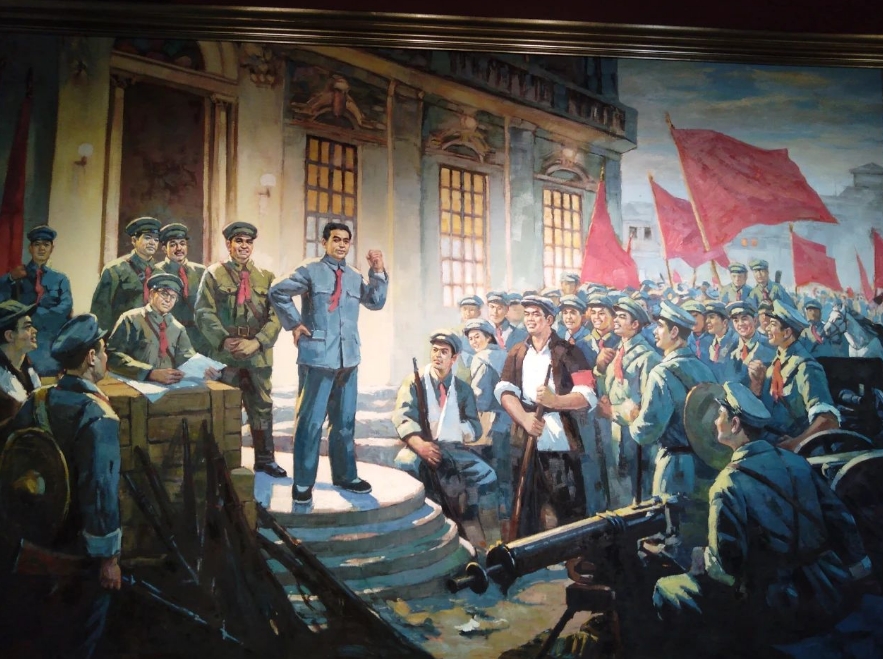
Oil painting ‘Nanchang Uprising’
Recommended Rating: ★★★★
The Nanchang Uprising Memorial Museum, located in Nanchang, Jiangxi Province, is a significant historical site commemorating the first armed uprising led by the Chinese Communist Party. The museum covers a large area and has rich exhibits, including numerous photographs, charts, artifacts, and artworks, vividly recreating the glorious history of the Nanchang Uprising.
The exhibition in the museum is themed “The Great Beginning,” using modern technology such as multimedia interaction and panoramic sculptures to vividly depict the rise of the People’s Liberation Army, from small to large, and from weak to strong. Additionally, the museum manages several historical sites related to the uprising, such as the Uprising Headquarters and the Officer Education Corps, offering visitors a valuable opportunity to gain in-depth knowledge of this historic event.
The Nanchang Uprising Memorial Museum is not only a national civilized unit and a first-class museum but also an important base for patriotic education. With its unique historical significance and rich exhibits, it attracts countless visitors and has become a prominent tourist attraction in Jiangxi Province and across the country.
Ticket Price: Free admission. A certain number of entry tickets are distributed each day, so remember to bring your ID to obtain a ticket.
Opening Hours: 9:00 AM to 5:00 PM. Sometimes the opening hours may be extended to 9:00 PM, with the last entry at 8:30 PM. Closed on Mondays, except for public holidays.
Address: 380 Zhongshan Road, Xihu District, Nanchang, Jiangxi
Transportation:
- Subway: Take Line 1 or Line 3 and get off at Bayi Square Station, or take Line 1 and get off at Wanshou Palace Station, then walk to the museum.
- Bus: Buses to Ximachi Station (Routes 18 Inner Loop, 205, 229, 830) or Waziqiao Station (Routes 5, 25, 25 Express, 230) can reach the museum.
- Driving: There are several nearby parking lots, such as the underground parking lot at Nanchang Uprising Memorial Museum, the parking lot at Xinlongji Plaza, and the underground parking lot at Wanshou Palace Historical and Cultural Block, providing convenient parking services.
5. Mount Sanqing
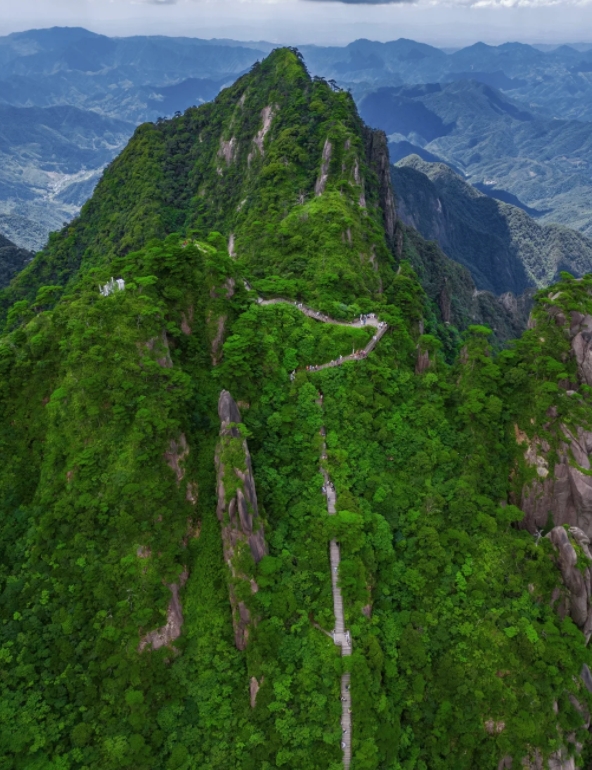
Recommended Rating: ★★★★★
Mount Sanqing, located at the border of Yushan County and Dexing City in Shangrao, Jiangxi Province, derives its name from the three peaks: Yujing, Yuxu, and Yuhua, which are said to resemble the Taoist deities Yuqing, Shangqing, and Taiqing seated at the mountain’s summit. It is a UNESCO World Natural Heritage site, a Global Geopark, a National Natural Heritage site, and a 5A-rated national tourist attraction. Often hailed as the “Number One Fairy Peak of Jiangnan,” it is a paradise for hiking enthusiasts with its breathtaking, poetic scenery.
Mount Sanqing stretches 12.2 kilometers from north to south and 6.3 kilometers from east to west, with its highest peak, Yujing, reaching 1,819.9 meters above sea level. The mountain showcases the world’s most densely distributed and diverse granite peak formations, along with rich biodiversity. The deep-rooted Taoist culture further adds to its unique charm. Its natural wonders—sea of clouds, sunrises, Buddha’s light, blooming flowers, and frost-covered trees—draw countless visitors eager to witness these spectacular sights.
Ticket Price: Adult ticket: 120 RMB per person. Half-price ticket: 60 RMB per person. Cable car tickets offer various options, including adult round-trip tickets, discounted round-trip tickets, adult one-way tickets, and discounted one-way tickets, ranging from 125 RMB to 70 RMB. Special discounts are available for specific groups, such as seniors, students, and holders of valid ID (such as active military personnel, journalists, disabled individuals, firefighters, etc.), as well as children.
Opening Hours: Spring and summer: 7:00 AM to 5:00 PM. Autumn: 7:30 AM to 4:30 PM. Winter: 8:00 AM to 4:00 PM.
Address: Border of Yushan County and Dexing City, Shangrao, Jiangxi Province
Transportation: From Shangrao City, you can drive or take public transportation, such as trains or buses. Shangrao has several railway stations and bus terminals offering convenient transportation to Mount Sanqing. For those flying, you can depart from Shangrao Sanqing Mountain Airport and then use ground transportation to reach the scenic area.(Sanqing,)
6. Wuyuan Huangling Scenic Area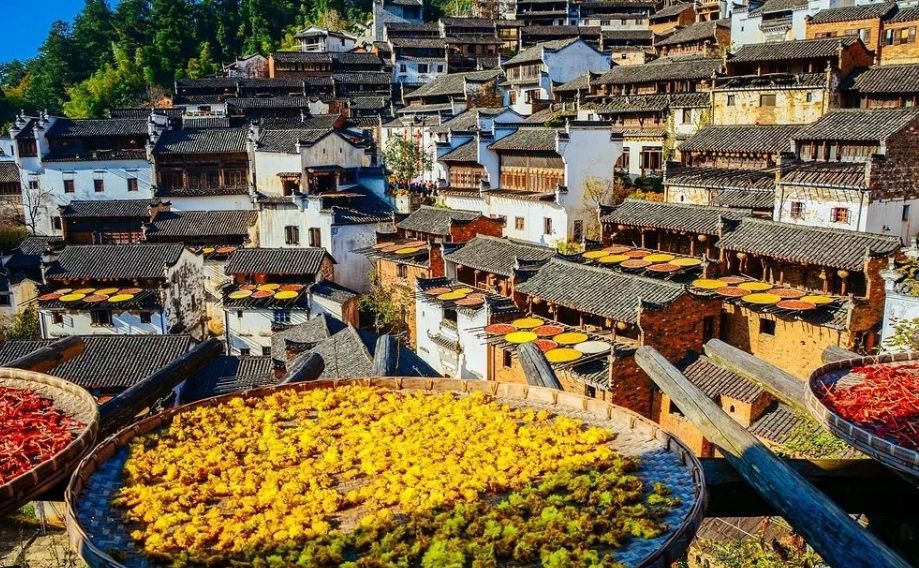
Recommended Rating: ★★★★★
Huangling Scenic Area in Wuyuan, located in Jiangwan Town, Shangrao City, Jiangxi Province, is a typical mountain village. Covering an area of about 5 square kilometers, it boasts natural landscapes such as terraced fields and ancient villages, earning it the nickname “Terrace Village in the Clouds.” The local houses are arranged in a fan-shaped, stepped pattern around a water source, forming a unique village layout. Huangling was established in the mid-Ming dynasty and has a history of over 500 years, with a rich cultural heritage.
In spring, Huangling is a sea of rapeseed flowers, with terraced fields creating picturesque scenes. In autumn, it becomes famous for the traditional sun-drying harvests, referred to as “Huangling Sun-drying,” which is hailed as one of the most beautiful symbols of China. The scenic area’s terraced flower fields, mountain village, and Hui-style ancient architecture also attract many tourists. The area offers other attractions, including a cable car, Sky Street, and plank roads, providing a diverse and enriching travel experience.
Ticket Price: Basic ticket: 120 RMB per person. Cable car: 100 RMB per person (uphill), 80 RMB per person (downhill). Other attractions such as the terraced sightseeing elevator, glass plank road, and rafting have separate prices.
Opening Hours: Sunday to Thursday: 8:30 AM to 5:30 PM. Fridays, Saturdays, and public holidays: 8:30 AM to 6:30 PM.
Address: Southeast of Jiangwan Town, Wuyuan County, Shangrao, Jiangxi Province, about 7 kilometers from Jiangwan and about 39 kilometers from Wuyuan County seat.
Transportation: Nearby airports include Huangshan and Jingdezhen, where you can fly and then transfer to high-speed trains or regular trains to reach Wuyuan. Within Wuyuan, there are direct tourist buses to Huangling Scenic Area, with ticket prices around 20 RMB per person. The buses operate from 7:30 AM to 5:00 PM, departing every 15 minutes. Driving is also a convenient option. Simply navigate to Huangling Scenic Area and exit at Jiangwan Highway, following navigation instructions to reach your destination.(Huangling Village, Wuyuan, Jiangxi: In-Depth Travel Experience and Tips to Avoid Common Pitfalls)
7. Wugong Mountain
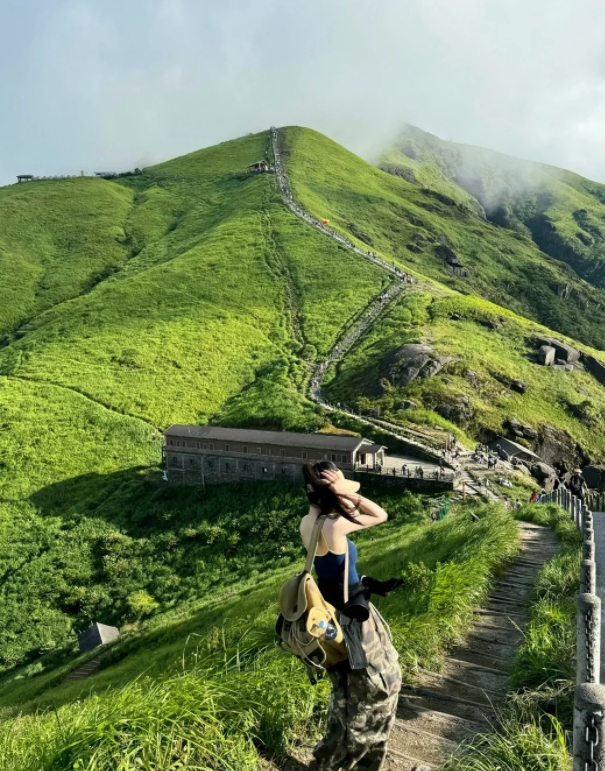
Recommended Rating: ★★★★★
Wugong Mountain is located in the central-western region of Jiangxi Province, China. The mountain range stretches in a northeast-southwest direction, spanning over 120 kilometers and covering an area of about 970 square kilometers. With its majestic peaks, the highest being Baihe Peak (Golden Summit) at an elevation of 1,918.3 meters, it is renowned as a natural sanctuary for both flora and fauna. The area is home to endangered species such as the Cabot’s tragopan and South China tiger, as well as rare plants like Taiwan pine and Rhododendron fortunei.
Beyond its stunning natural landscapes, Wugong Mountain is steeped in history and culture. Since the Han and Jin dynasties, it has been regarded as a sacred retreat for Taoist and Buddhist practitioners. Many scholars and famous historical figures have visited the mountain, leaving behind a rich legacy of poetry and stories. In addition to being a 5A-rated national tourist attraction, it is also a National Geopark and National Forest Park, and in 2024, it was listed as a member of the Global Geoparks Network.
Ticket Price: Online booking for adults is ¥70, and student tickets are ¥50. Additional options include cable car tickets, Zhong’an cable car tickets (uphill or downhill), and combo tickets for the entrance and Zhong’an cable car.
Opening Hours: During the off-peak season (non-holidays), the park is open from 8:00 AM to 5:00 PM, with the last ticket sold at 4:00 PM. During the peak season (holidays), the hours are from 8:00 AM to 5:30 PM, with the last ticket sold at 4:40 PM.
Address: Located in Luxi County, Pingxiang City, Jiangxi Province, it is part of the northern branch of the Luoxiao Mountain Range.
Transportation: Direct buses to Wugong Mountain are available from both Pingxiang North Station and Pingxiang Station. From Pingxiang North Station, buses run from 7:30 AM to 5:10 PM, with a ticket price of ¥27. From Pingxiang Station, buses operate from 6:40 AM to 5:20 PM, with a ticket price of ¥22. The scenic area also offers free shuttle buses to the Shigu Temple trailhead. Two cable car routes, Zhong’an and Jinding, are available for quick access to the mountain.(Essential Guide to Hiking Wugong Mountain: The Ultimate Travel Tips!)
8. Yangshimu Scenic Area, Anfu County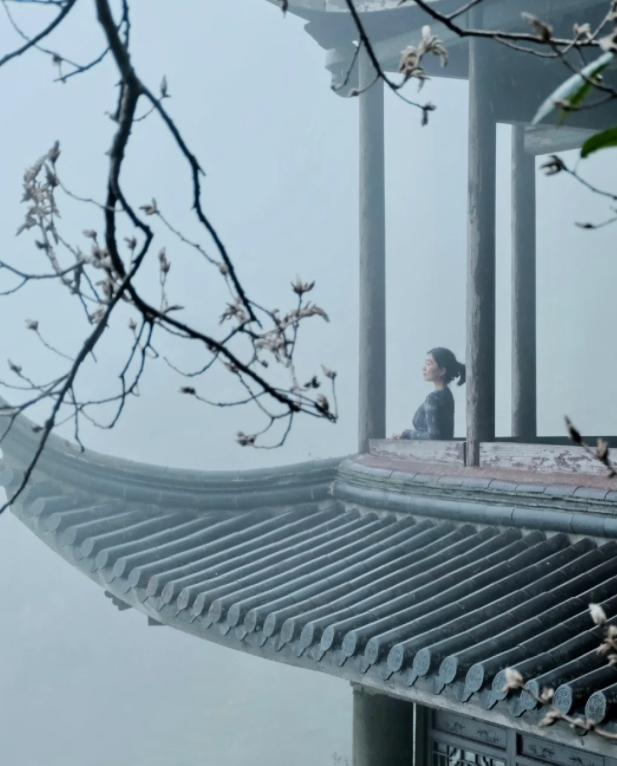
Recommended Rating: ★★★★
Yangshimu Scenic Area, located in Anfu County, Ji’an City, Jiangxi Province, is a 4A-rated national scenic area covering 37.5 square kilometers. It neighbors Wugong Mountain and features a striking landscape dominated by granite peak formations. The highest point, Shisun Peak, reaches an elevation of 1,764 meters. The area’s geological formations were shaped over a long history, influenced by multiple marine submersions and the Himalayan orogeny, creating the awe-inspiring peaks and deep valleys visible today.
Yangshimu Scenic Area boasts rich vegetation and extensive forest coverage, with a vast volume of forest resources. It is home to over 2,152 species of higher plants, many of which are rare. Additionally, more than 300 species of wild vertebrates reside in the area, including several nationally protected animals.
Visitors to Yangshimu can enjoy breathtaking natural sights, such as the Shisun Peak Cloud Waterfall and Cloud Grassland. The unique geological features, such as the Cloudy Stone Bamboo Shoots and the Eighteen Rows, offer an unforgettable experience of nature’s wonders. The area also holds significant cultural value, being one of Taoism’s sacred mountains.
Ticket Price: Adult tickets during peak season start at ¥233, with discounted prices available for children, students, seniors, military personnel, and disabled individuals.
Opening Hours: During the peak season (March 16 to November 15), the park is open from 8:00 AM to 5:30 PM. During the off-peak season (November 16 to March 15 of the following year), the hours are from 8:30 AM to 5:00 PM.
Address: Yangshimu Scenic Area, Taishan Township, Anfu County, Ji’an City, Jiangxi Province
Transportation: Visitors using public transportation can take buses or long-distance coaches from their location to the scenic area. For those driving, GPS navigation can be used to find the optimal route to the scenic area.(Ji’an | Anfu Two-Day Itinerary)
9. Mount Longhu
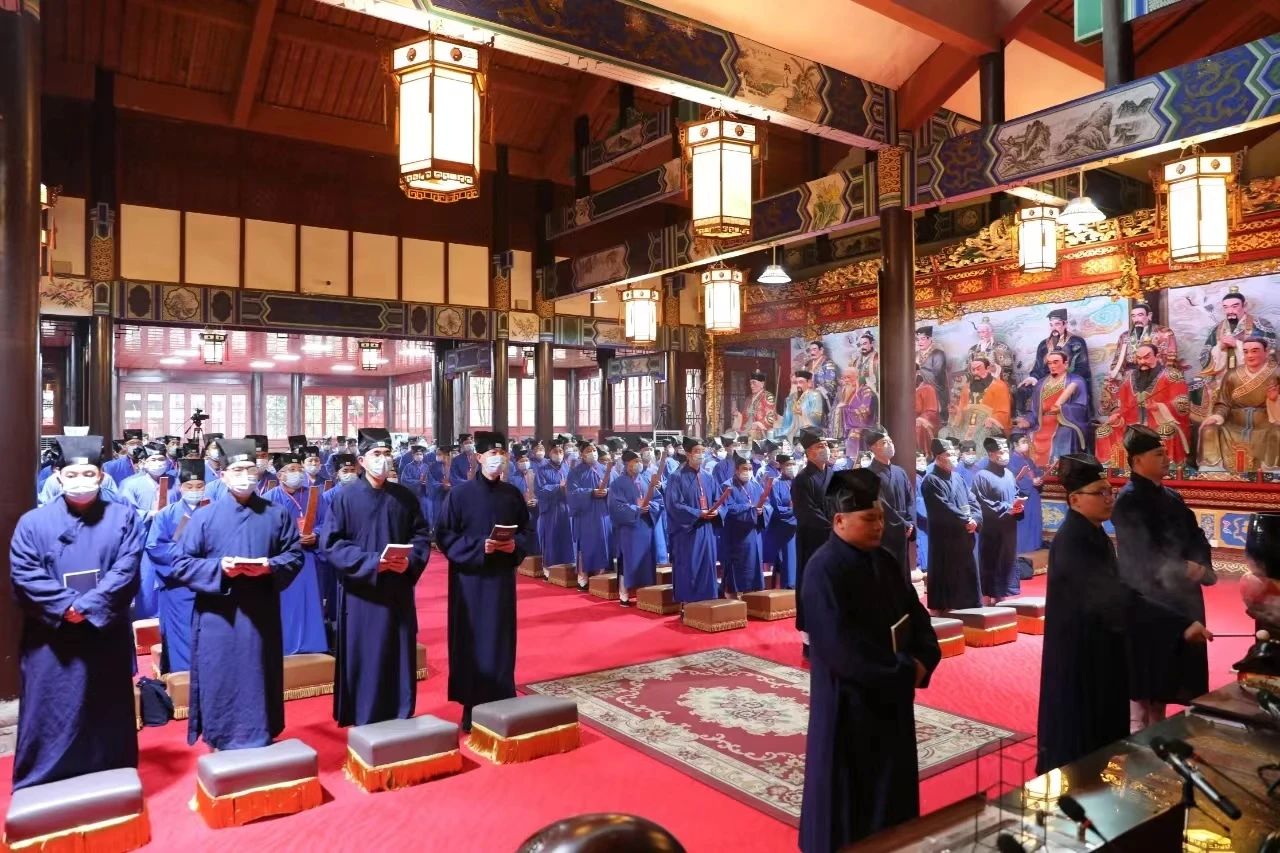
Recommended Rating: ★★★★★
Mount Longhu, located 20 kilometers southwest of Yingtan City, Jiangxi Province, is a prime example of China’s Danxia landform, celebrated for its picturesque landscapes, rich history, and profound cultural heritage. It is recognized as China’s eighth World Natural Heritage Site, a UNESCO Global Geopark, a dual-listed National Natural and Cultural Heritage Site, and a 5A-rated national tourist attraction. The name “Mount Longhu” (Dragon and Tiger Mountain) comes from the legend of Zhang Daoling, the founder of Zhengyi Taoism in the mid-Eastern Han Dynasty, who practiced alchemy here. It is said that when his elixirs were completed, dragons and tigers appeared, giving the mountain its name.
The mountain’s unique terrain includes Tianmen Mountain, the highest peak, standing at 1,300 meters. The area is known for its three natural wonders: its red cliffs, emerald waters, and ancient cliff tombs. Additionally, Mount Longhu is the birthplace of Taoism, with the descendants of Zhang Daoling living here for generations—now in their 63rd generation. Taoist landmarks like the Tianshi Mansion and Shangqing Palace further showcase its deep Taoist cultural significance.
Beyond its scenic beauty and cultural depth, Mount Longhu enjoys a pleasant climate, with high levels of negative ions in the air, making it a natural oxygen bar and an ideal destination for relaxation and vacation.
Ticket Price: During the off-peak season (January 1 to February 29, 2024), the full ticket price for the scenic area, including the sightseeing bus and bamboo raft, is ¥190 per person, with a discounted rate of ¥145 per person for a two-day tour. In the peak season (March 1 to December 31, 2024), the full price is ¥135 per person, with a discounted two-day tour ticket costing ¥45.
Opening Hours: Open year-round
Address: 20 kilometers southwest of Yingtan City, Jiangxi Province
Transportation: Visitors can take a high-speed train or regular train to Yingtan Station or Yingtan North Station, then transfer to a bus or shuttle directly to the Mount Longhu Tourist Center. For those driving, simply follow GPS navigation to “Mount Longhu Tourist Center” to reach your destination. If arriving by plane, fly to Nanchang Changbei Airport and then take a high-speed train or long-distance bus to Mount Longhu.(The First Mountain of Taoism in China: Longhu Mountain)
10. Jinggang Mountain
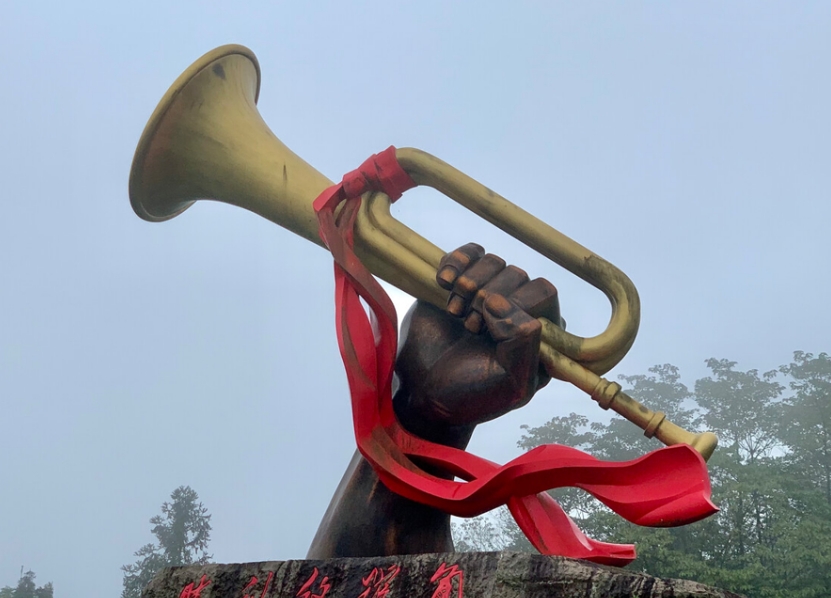
Recommended Rating: ★★★★
Jinggang Mountain, located on the border between Jiangxi and Hunan provinces, lies in the middle section of the Luoxiao Mountain Range. Known as the cradle of the Chinese Revolution, it is not only a scenic natural destination but also a site of significant historical and cultural importance. The mountain features steep terrain and dense forests, boasting rich biodiversity and a warm subtropical monsoon climate.
At Jinggang Mountain, visitors can enjoy spectacular natural scenery, such as the Ten-Mile Azalea Forest in Bijia Mountain, which bursts into bloom every late spring and early summer, creating a sea of flowers. In addition to its natural beauty, the mountain is also home to numerous historical landmarks, including the old revolutionary base of Jinggang Mountain, which stands as a testament to the Chinese Communist Party’s efforts in establishing rural revolutionary bases during difficult times.
Ticket Price: During the peak season, adult tickets are ¥240 (including the sightseeing bus), and student tickets start at ¥82. Tickets that only include park entry start at ¥160 for adults.
Opening Hours: From February 16 to April 30, the park is open from 8:00 AM to 5:00 PM. From May 1 to May 5, hours are extended to 7:00 AM to 7:00 PM. From May 6 to November 15, hours return to 8:00 AM to 5:00 PM. From November 16 to February 15, the following year, the park is open from 9:00 AM to 6:00 PM.
Address: Ciping Town, Jinggangshan City, Ji’an, Jiangxi Province, situated at the border between Xiangdong, Jiangxi, and western Hunan. The western slope is in Yanling County, Zhuzhou City, Hunan Province, and the eastern slope is in Jinggangshan City, Ji’an, Jiangxi Province.
Transportation: Visitors can take a high-speed train or regular train to Jinggangshan Station or Ji’an West High-Speed Rail Station, then transfer to a bus or coach to the scenic area. For those flying, you can land at Ji’an Jinggangshan Airport and take an airport bus or taxi to the city center. Additionally, the city center offers buses and taxis for convenient travel within the scenic area.(Ultimate Guide to a Two-Day Trip to Jinggangshan)
11,Poyang Lake National Wetland Park
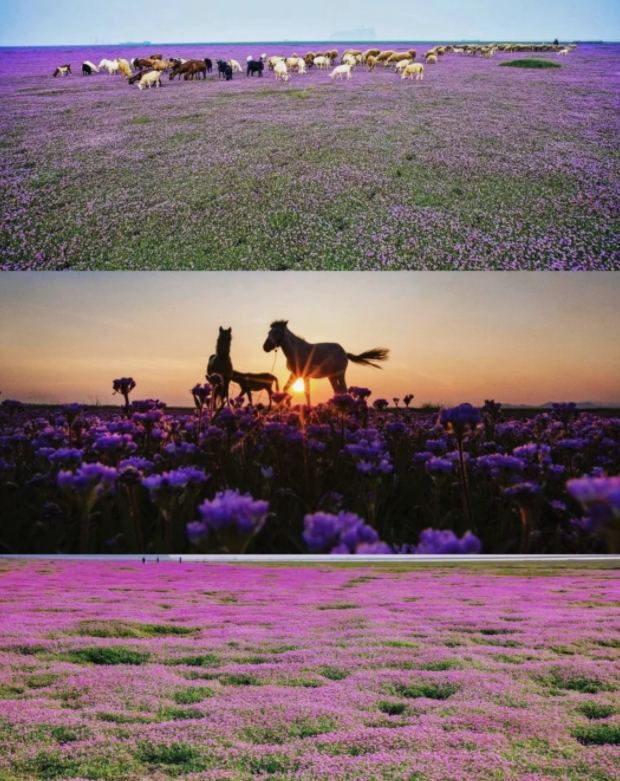
12,Mingyue Mountain
13. Ku’an Town
Recommended Rating: ★★★★
Ku’an Town is a distinctive cultural and tourism town located on the southern side of Yantian Mountain National Forest Park in Xinyu City, Jiangxi Province. Surrounded by lush greenery and stunning landscapes, it has been a gathering place for scholars and literati throughout history. The town revolves around Zen culture, offering experiences centered on Zen lifestyle, Zen wellness, and Zen living. It integrates dining, accommodation, transportation, sightseeing, shopping, and entertainment, aiming to create a new model for spiritual retreats.
With a vast area and architecture inspired by Zen landscapes and the elegance of Tang and Song dynasties, Ku’an Town offers visitors an immersive journey into Zen culture. Guests can experience a simple way of life, free from worldly distractions, and enjoy a peaceful retreat reminiscent of Tao Yuanming’s idyllic paradise. The town also hosts various cultural activities and performances, such as the large-scale outdoor water show “Clouds and Water, Heart of Zen,” which delivers a stunning visual and auditory experience.
Ticket Price: Adult tickets are ¥69 per person, with discounted rates available for children and seniors.
Opening Hours: Open year-round, from 9:30 AM to 9:30 PM (last entry at 9:00 PM).
Address: 276 Yuexue Road, Yushui District, Xinyu City, Jiangxi Province (Northwest Gate of the Affiliated School of Beijing Normal University), located in the scenic Yantian Mountain area.
Transportation: From Xinyu North Station, take the “Fairy Lake High-Speed Rail Tourist Line” and get off at the “Beijing Normal University Station.” From there, it is an 876-meter walk to the town. For those driving, set your GPS to 276 Yuexue Road, Yushui District, Xinyu City, Jiangxi Province (Northwest Gate of the Affiliated School of Beijing Normal University). The town provides parking facilities for self-driving visitors. Taxis or ridesharing services are also available depending on your preference.
14. Jingdezhen Ancient Kiln Folk Customs Museum
Recommended Rating: ★★★★
The Jingdezhen Ancient Kiln Folk Customs Museum is a comprehensive cultural and tourism site located in Changjiang District, Jingdezhen City, Jiangxi Province. It combines cultural exhibitions, ceramic-making experiences, and recreational activities, preserving numerous ancient kiln relics and showcasing traditional folk culture, offering a deep dive into Jingdezhen’s rich ceramic heritage.
In the museum, the Ancient Kilns Exhibition Area recreates the authentic scenes of ancient porcelain workshops and kilns, allowing visitors to step back in time and experience the historical prosperity of the ceramic industry. The Folk Customs Exhibition Area showcases a wealth of ceramic folk traditions and techniques, highlighting the unique charm of Jingdezhen’s ceramic artistry.
The museum also offers interactive experiences such as hands-on ceramic making and ceramic music performances, allowing visitors to gain deeper insights into ceramic culture through participation. Whether you are a ceramic enthusiast or a cultural tourist, the Jingdezhen Ancient Kiln Folk Customs Museum offers something for everyone.
Ticket Price: Student and senior tickets (for ages 60 to 65) are priced at ¥45, while adult tickets cost ¥85.
Opening Hours: Open year-round from 8:00 AM to 5:00 PM, with extended hours during the Chinese New Year from 8:00 AM to 5:30 PM.
Address: Panlonggang, Fengshushan, Changjiang District, Jingdezhen City, Jiangxi Province, 1 Gucyao Road, Porcelain Capital Avenue.
Transportation: For long-distance travelers, you can fly into Jingdezhen Luojia Airport and take a taxi or bus to the museum. Alternatively, from Jingdezhen Railway Station, you can take a bus or taxi to the museum. For self-driving visitors, use a navigation system to find the best route.
15,Yaoli Ancient Town
16,Jingdezhen Ceramic Museum (Jingdezhen China Ceramic Museum)
17,Fairy Lake
18,Gezao Mountain Scenic Area in Zhangshu City
19,Damao Mountain Scenic Area in Dexing City
20,Tianlong Mountain in Ganzhou
21,The ancient city wall of Ganzhou
22,Guanxi Xinwei
23,Wangxiangu Valley Scenic Area